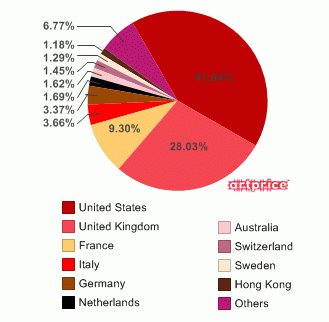Europe leads the art market
[15 Feb 2004]
In the first half of 1999, US auctioneers handled more than 64% of art market turnover. Three years later, in 2002, after some excellent London sales in July—including Sotheby’s GBP 45 million for The Massacre of the Innocents by Peter Paul Rubens on the 10th—the UK and US were running neck and neck in terms of turnover. At the time, this exceptional state of affairs was put down to a few spectacular sales in Britain and a chill economic climate in America. But the exception now seems to have become the rule
US market share has been stable at around 42% for two years now, 6 percentage points below 2001 levels.
So why has the US failed to recapture the market share surrendered since 2001?Strong November sales may have assuaged the sense of crisis, but US turnover still fell by 22% in 2003. The reasons were fewer records and fewer lots sold. The May impressionist sales in New York turned over USD 100 million less than the previous year. And lots bought in continued to rise to an average of 25% compared to 22% in 2000.
Auction sales turnover 2003 / weight by countryFine Art auction sales 
Europe has taken advantage of the turmoil to strengthen its market leadership, with London, Paris and Rome leading the charge. With 54% of global fine art sales, Europe now has an unprecedented grip on the market. By volume, its supremacy is even clearer: 81% of global sales. All the same, the British, French, Germans and Scandinavians have not been untouched by the crisis—far from it.
London has far and away the biggest market share in Europe, almost 28% of the global market, a share that remained stable versus 2002 as sales fell in line with the US’s, by 21%. This drop is primarily due to a sharp contraction in volumes. However, the year was marked by a few good sales. Sotheby’s auction on 23 June 2003 brought in more than GBP 33 million and included a record GBP 11.3 million sale for Egon Schiele. This turned out to be the year’s star auction in Europe.
The exceptional Breton sale was not enough to prevent French transaction volumes sliding 25% against 2002 levels. The fall here was all the more marked as the benefits of the 2001 auction reform were cancelled out by the falling dollar. In the current economic context, it is hard going for those seeking to open up the French market to the outside world. That said, Paris still managed to hang onto number one spot in terms of lots sold.
Like Germany and Switzerland, France also saw a large number of bought-ins: 39% of lots at French auctions failed to find a buyer, versus 32% in the UK and 24% in Sweden.Some European countries have done well in the competitive climate, notably Italy. The dynamism of international auctioneers like Sotheby’s, and also domestic auction houses such as Farsetti and Meeting Art won Italy an extra 0.8% of the market compared with 2002. But Italy was not the only country to benefit from the US slowdown. Germany shed only 8% of its turnover, and strengthened its position internationally, gaining 1% of the market from 2002 levels. Even France, still hanging onto third place, captured another 0.6% of the market.
The art market in the southern hemisphere still lacks momentum. Australia remains the leader, a long way ahead of South Africa and Argentina. But its turnover did advance 10% in 2003, thanks to some successes at Sotheby’s Melbourne.
In the present downturn, Sotheby’s is emerging as the best auction house in most markets. Its fine art sales were more than EUR 20 million ahead of its main rival, Christie’s in 2003. The year also saw Phillips de Pury & Luxembourg on the back foot. Apart from a handful of prestigious sales, it took a step back following the failure of its impressionist sale in November 2002. In all, the auction house recorded fine art sales of just EUR 30 million, compared with more than EUR 240 million in 2001.




 0
0
